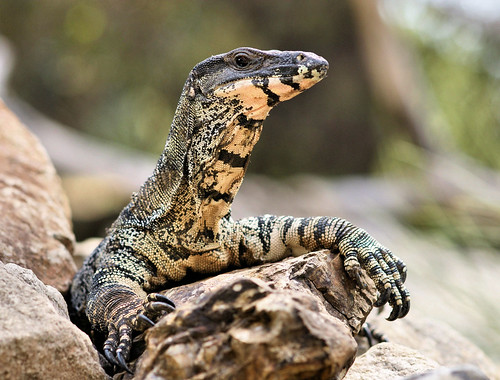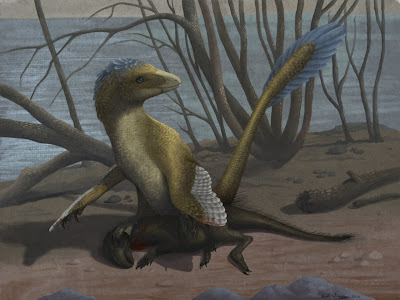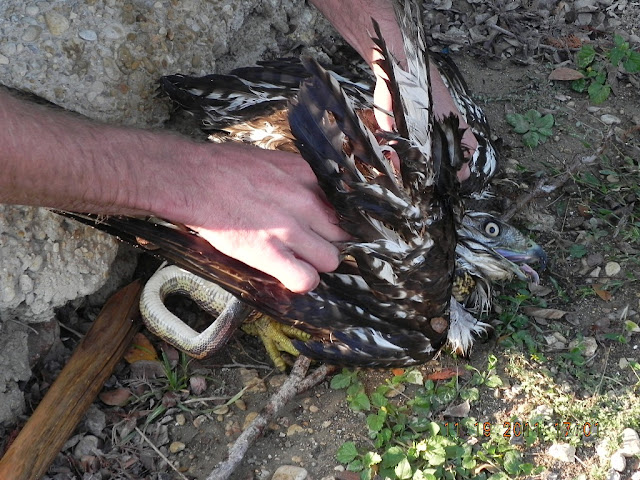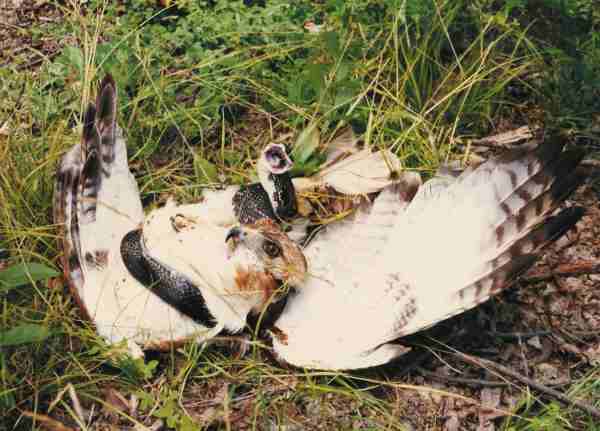Post by DinosaurMichael on May 31, 2013 5:22:43 GMT 5
Green Anaconda - Eunectes murinus
Eunectes murinus is a non-venomous boa species found in South America. It is the heaviest known snake species. The term anaconda (without further qualification) often refers to this species, though the term could also apply to other members of the genus Eunectes. Eunectes murinus is found in South America east of the Andes, in countries including Colombia, Venezuela, the Guianas, Ecuador, Peru, Bolivia, Brazil, the island of Trinidad and as far south as northern Paraguay. Anacondas live in swamps, marshes, and slow-moving streams, mainly in the tropical rain forests of the Amazon and Orinoco basins. They are cumbersome on land, but stealthy and sleek in the water. Their eyes and nasal openings are on top of their heads, allowing them to lie in wait for prey while remaining nearly completely submerged. The Green Anaconda is one of the world's longest snakes, reaching more than 6.6 m (22 ft) long. Reports of anacondas 35–40 feet or even longer also exist, but such claims need to be regarded with caution as no specimens of such lengths have ever been deposited in a museum and hard evidence is lacking. Although the reticulated python is longer, the anaconda is the heaviest snake. The longest (and heaviest) scientifically recorded specimen was a female measuring 521 cm (17 ft 1 in) long and weighing 97.5 kilograms (215 lb).

Deinonychus - Deinonychus antirrhopus
Deinonychus (/da??n?n?k?s/ dy-non-i-k?s; Greek: äåéÃüò, 'terrible' and ?Ãõî, genitive ?Ãõ÷ïò 'claw') was a genus of carnivorous dromaeosaurid dinosaur. There is one described species, Deinonychus antirrhopus. This 3.4 meter (11 ft) long dinosaur lived during the early Cretaceous Period, about 115–108 million years ago (from the mid-Aptian to early Albian stages). Fossils have been recovered from the U.S. states of Montana, Wyoming, and Oklahoma, in rocks of the Cloverly Formation and Antlers Formation, though teeth that may belong to Deinonychus have been found much farther east in Maryland. Paleontologist John Ostrom's study of Deinonychus in the late 1960s revolutionized the way scientists thought about dinosaurs, leading to the "dinosaur renaissance" and igniting the debate on whether dinosaurs were warm-blooded or cold blooded. Before this, the popular conception of dinosaurs had been one of plodding, reptilian giants. Ostrom noted the small body, sleek, horizontal posture, ratite-like spine, and especially the enlarged raptorial claws on the feet, which suggested an active, agile predator. "Terrible claw" refers to the unusually large, sickle-shaped talon on the second toe of each hind foot. The fossil YPM 5205 preserves a large, strongly curved ungual. In life, archosaurs have a horny sheath over this bone which extends the length. Ostrom looked at crocodile and bird claws and reconstructed the claw for YPM 5205 as over 120 millimetres (4.7 in) long. The species name antirrhopus means “counter balance”, which refers to Ostrom's idea about the function of the tail. As in other dromaeosaurids, the tail vertebrae have a series of ossified tendons and super-elongated bone processes. These features seemed to make the tail into a stiff counterbalance, but a fossil of the very closely related Velociraptor mongoliensis (IGM 100/986) has an articulated tail skeleton that is curved laterally in a long S–shape. This suggests that, in life, the tail could bend to the sides with a high degree of flexibility. Based on the largest known specimens, Deinonychus could reach at least 3.4 metres (11 ft 2 in) in length, with a skull length of 410 mm (16.1 in), a hip height of 0.87 metres (2 ft 10 in), and an estimated weight of 73 kilograms (160 lb). Its skull was equipped with powerful jaws lined with around seventy curved, blade-like teeth. Studies of the skull have progressed a great deal over the decades. Ostrom reconstructed the partial, imperfectly preserved, skulls that he had as triangular, broad, and fairly similar to Allosaurus. Additional Deinonychus skull material and closely related species found with good three-dimensional preservation show that the palate was more vaulted than Ostrom thought, making the snout far narrower, while the jugals flared broadly, giving greater stereoscopic vision. The skull of Deinonychus was different from that of Velociraptor, however, in that it had a more robust skull roof like that of Dromaeosaurus, and did not have the depressed nasals of Velociraptor. Both the skull and the lower jaw had fenestrae (skull openings) which reduced the weight of the skull. In Deinonychus, the antorbital fenestra, a skull opening between the eye and nostril, was particularly large. Deinonychus possessed large hands (manus) with three claws on each forelimb. The first digit was shortest and the second was longest. Each hind foot bore a sickle-shaped claw on the second digit, which was probably used during predation.

Eunectes murinus is a non-venomous boa species found in South America. It is the heaviest known snake species. The term anaconda (without further qualification) often refers to this species, though the term could also apply to other members of the genus Eunectes. Eunectes murinus is found in South America east of the Andes, in countries including Colombia, Venezuela, the Guianas, Ecuador, Peru, Bolivia, Brazil, the island of Trinidad and as far south as northern Paraguay. Anacondas live in swamps, marshes, and slow-moving streams, mainly in the tropical rain forests of the Amazon and Orinoco basins. They are cumbersome on land, but stealthy and sleek in the water. Their eyes and nasal openings are on top of their heads, allowing them to lie in wait for prey while remaining nearly completely submerged. The Green Anaconda is one of the world's longest snakes, reaching more than 6.6 m (22 ft) long. Reports of anacondas 35–40 feet or even longer also exist, but such claims need to be regarded with caution as no specimens of such lengths have ever been deposited in a museum and hard evidence is lacking. Although the reticulated python is longer, the anaconda is the heaviest snake. The longest (and heaviest) scientifically recorded specimen was a female measuring 521 cm (17 ft 1 in) long and weighing 97.5 kilograms (215 lb).

Deinonychus - Deinonychus antirrhopus
Deinonychus (/da??n?n?k?s/ dy-non-i-k?s; Greek: äåéÃüò, 'terrible' and ?Ãõî, genitive ?Ãõ÷ïò 'claw') was a genus of carnivorous dromaeosaurid dinosaur. There is one described species, Deinonychus antirrhopus. This 3.4 meter (11 ft) long dinosaur lived during the early Cretaceous Period, about 115–108 million years ago (from the mid-Aptian to early Albian stages). Fossils have been recovered from the U.S. states of Montana, Wyoming, and Oklahoma, in rocks of the Cloverly Formation and Antlers Formation, though teeth that may belong to Deinonychus have been found much farther east in Maryland. Paleontologist John Ostrom's study of Deinonychus in the late 1960s revolutionized the way scientists thought about dinosaurs, leading to the "dinosaur renaissance" and igniting the debate on whether dinosaurs were warm-blooded or cold blooded. Before this, the popular conception of dinosaurs had been one of plodding, reptilian giants. Ostrom noted the small body, sleek, horizontal posture, ratite-like spine, and especially the enlarged raptorial claws on the feet, which suggested an active, agile predator. "Terrible claw" refers to the unusually large, sickle-shaped talon on the second toe of each hind foot. The fossil YPM 5205 preserves a large, strongly curved ungual. In life, archosaurs have a horny sheath over this bone which extends the length. Ostrom looked at crocodile and bird claws and reconstructed the claw for YPM 5205 as over 120 millimetres (4.7 in) long. The species name antirrhopus means “counter balance”, which refers to Ostrom's idea about the function of the tail. As in other dromaeosaurids, the tail vertebrae have a series of ossified tendons and super-elongated bone processes. These features seemed to make the tail into a stiff counterbalance, but a fossil of the very closely related Velociraptor mongoliensis (IGM 100/986) has an articulated tail skeleton that is curved laterally in a long S–shape. This suggests that, in life, the tail could bend to the sides with a high degree of flexibility. Based on the largest known specimens, Deinonychus could reach at least 3.4 metres (11 ft 2 in) in length, with a skull length of 410 mm (16.1 in), a hip height of 0.87 metres (2 ft 10 in), and an estimated weight of 73 kilograms (160 lb). Its skull was equipped with powerful jaws lined with around seventy curved, blade-like teeth. Studies of the skull have progressed a great deal over the decades. Ostrom reconstructed the partial, imperfectly preserved, skulls that he had as triangular, broad, and fairly similar to Allosaurus. Additional Deinonychus skull material and closely related species found with good three-dimensional preservation show that the palate was more vaulted than Ostrom thought, making the snout far narrower, while the jugals flared broadly, giving greater stereoscopic vision. The skull of Deinonychus was different from that of Velociraptor, however, in that it had a more robust skull roof like that of Dromaeosaurus, and did not have the depressed nasals of Velociraptor. Both the skull and the lower jaw had fenestrae (skull openings) which reduced the weight of the skull. In Deinonychus, the antorbital fenestra, a skull opening between the eye and nostril, was particularly large. Deinonychus possessed large hands (manus) with three claws on each forelimb. The first digit was shortest and the second was longest. Each hind foot bore a sickle-shaped claw on the second digit, which was probably used during predation.














